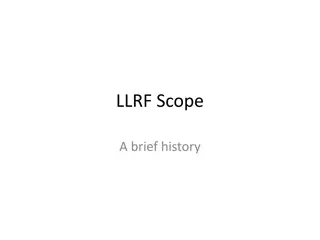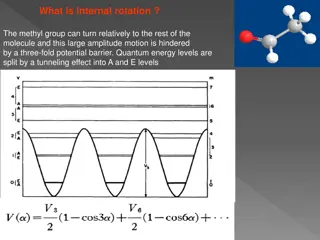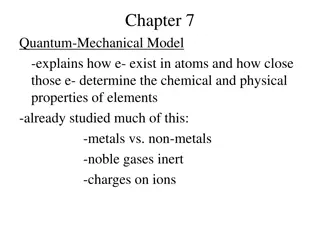Understanding Waves, Light, & Sound: Vocabulary and Concepts
This chapter covers essential vocabulary and concepts related to waves, light, and sound, including amplitude, crest, diffraction, Doppler effect, electromagnetic wave, frequency, interference, longitudinal wave, mechanical wave, medium, photon, pitch, reflection, refraction, sound wave, standing wa
8 views • 21 slides
Understanding Sound Waves and Human Hearing
Sound waves are longitudinal waves where particles move in the same direction. The human body hears sounds through vibrations reaching the cochlea, which produces electrical signals for the brain to interpret. Properties of sound waves include traveling through various mediums at different speeds. F
2 views • 10 slides
Exploring Special Senses: Ears, Eyes, and Sound Waves
Explore the fascinating world of special senses including equilibrium, hearing, vision, and the science behind sound waves. Delve into the anatomy of the ears, inner cochlea, and trochlea, as well as what gives eyes their color. Discover how sound frequency and amplitude affect pitch and volume, and
9 views • 25 slides
Real-Time Digital Signal Processing Lab: Quantization and Resolution Overview
Explore quantization and resolution techniques in real-time digital signal processing. Topics include quantization error analysis, total harmonic distortion, noise immunity in communication systems, human sensory resolution, analog-to-digital conversion, and uniform amplitude quantization. Dive into
7 views • 19 slides
Overview of LLRF Scope and Development
The LLRF system is responsible for controlling the phase and amplitude of cavities in the linac system. The cost book details the budget for implementing the LLRF system in 155 systems. Adaptations were made to the PEG for delivering and installing the LLRF systems. A schedule outlines the developme
0 views • 8 slides
Creating and manipulating sound waves
Learn how to create and manipulate sound waves using Audacity or similar tools. Import audio files, record sound directly, zoom in for a closer look at waveforms, select portions for editing, and understand amplitude values for binary representation. Enhance your audio editing skills with practical
0 views • 11 slides
Comparative Analysis of Pulse and Amplitude Modulations in Cellular Applications
Explore the comparison between various pulse modulations like PM1 and PM3, alongside amplitude modulation (AM) in the context of cellular technologies such as 2G, 4G(LTE), and advances in 5G NR. The discussion includes considerations of modulation frequency, duty cycles, and spectrum analysis to und
0 views • 8 slides
Understanding Waves: A Visual Exploration
Explore the fascinating world of waves through visually engaging images and interactive clickers. Learn about different types of waves, including longitudinal and transverse waves, and discover what waves carry - energy, not matter. Delve into the concepts of mechanical and electromagnetic waves, an
1 views • 37 slides
Understanding AC Fundamentals in Basic Electrical Engineering
Exploring key concepts in AC fundamentals, including definitions of alternating quantities, important terms like amplitude, time period, instantaneous value, frequency, and angular frequency. The presentation covers AC circuits with resistance, inductance, and capacitance, providing insights into RM
0 views • 25 slides
Understanding Electromagnetic Induction and Wave Characteristics
Explore the concept of electromagnetic induction, its explanation by scientists, and the presence of a black strip on your debit card. Discover the basic characteristics of waves, including amplitude, crest, trough, wavelength, phase, frequency, and speed. Dive into the world of waves and their ener
0 views • 99 slides
Exploring the 7 Key Characteristics of Sound Waves
Dive into the fascinating world of sound waves with an exploration of their 7 essential characteristics. Learn about attributes such as amplitude, frequency, phase, velocity, wavelength, harmonics, and envelope (ADSR), each playing a crucial role in shaping how we experience and interpret sound. Und
0 views • 8 slides
Understanding Analog Data and Digital Signal Transmission
This lecture delves into the concepts of analog data, digital signals, and the processes involved in data transmission and digital communication. It covers topics such as Pulse Amplitude Modulation (PAM), Analog-to-Digital Conversion, and Sampling. The conversion of analog signals to digital signals
0 views • 34 slides
Understanding Feynman Diagrams in Particle Physics
Feynman diagrams, developed by Richard Feynman in the 1940s, are a graphical technique to represent particle interactions in space-time. These diagrams use lines to depict particles, with fermions moving forward in time and antifermions moving backward. Vertices in the diagrams represent points wher
1 views • 19 slides
Introduction to Quadrature Amplitude Modulation (QAM) in Digital Communication
Quadrature Amplitude Modulation (QAM) is a widely used modulation technique for transmitting data signals onto a carrier in communication systems. It offers advantages like increased efficiency by combining amplitude and phase variations, making it suitable for various radio and data delivery applic
0 views • 15 slides
Best Lighting Services in Abbotsford
If you want the Best Lighting Services in Abbotsford, visit Amplitude Electrical Group. They are your trusted expert in delivering quality residential and commercial electrical solutions. Owned and operated by Conrad Schnitzler with 6 years of experi
1 views • 6 slides
Techniques for Hadron Spectroscopy Studies at LHCb
Hadron spectroscopy studies at LHCb focus on searching for new hadrons, measuring their properties like lineshape, lifetime, and decay modes. The LHCb detector is optimized for collecting, reconstructing, and identifying signals to improve knowledge about hadron spectroscopy. Development of data ana
0 views • 30 slides
Digital Communications Fundamentals and Applications in CTE Department 2018-2019
This content delves into the Digital Communications course in the CTE Department during the academic year 2018-2019. It covers topics such as Binary Amplitude Shift Keying (BASK), Generation and Detection of BASK, Differential Phase Shift Keying (DPSK), DPSK Generator, and the application of Digital
0 views • 16 slides
Understanding Sound Waves: Exploring Wave Phenomena in Physics
Delve into the intricacies of sound waves in Physics with a focus on standing waves, boundary conditions, amplitude variations, and wave interactions. Explore concepts like harmonic wave addition, pulse encounters, and outcomes at fixed and free ends of a string. Discover how different scenarios aff
0 views • 22 slides
Understanding the Wave Theory of Light and Electromagnetic Spectrum
Explore the fascinating world of electromagnetic waves, visible light, and the wave theory through concepts such as wavelength, frequency, amplitude, and the speed of light. Understand how these elements are interconnected, and discover the diverse range of the electromagnetic spectrum. Dive into th
0 views • 77 slides
Understanding the Physics of Cardiac Murmurs: A Comprehensive Overview
Cardiac murmurs are audible turbulent sound waves originating from the heart and vascular system, resulting from blood flow turbulence. This informative content explores the physics behind murmurs, covering aspects such as amplitude, pitch, and timbre. It delves into how the intensity and frequency
0 views • 10 slides
Understanding CRO (Cathode Ray Oscilloscope): Working and Applications
In this tutorial on CRO, you will learn about the working principles of a Cathode Ray Oscilloscope (CRO) and its applications in modern electronics. The CRO is crucial for analyzing waveforms by plotting amplitude against the x-axis and y-axis. Explore the components of a CRO and understand how volt
2 views • 48 slides
Understanding Sound and Radio Technology
Exploring the significance of the rebels' first radio broadcast, the mechanics of radio communication, the production of sound through vibrations, and the importance of amplitude in sound properties. Discover how radios work, transmit signals, and impact our daily lives.
0 views • 19 slides
Exploring Essential Questions About Sound Waves
Delve into the fundamental aspects of sound waves through essential questions, observations of sound wave behavior, key facts, and measurements. Understand the nature of sound waves, including frequency, amplitude, speed of sound, and perception attributes like pitch and intensity level. Discover ho
0 views • 20 slides
Exploring the Nature of Waves and Sound
Understanding the nature of waves, both transverse and longitudinal, and their properties such as amplitude, wavelength, and frequency. Delve into the world of water waves, periodic waves, and the speed of waves on a string. Learn about the longitudinal nature of sound waves, the audible frequency r
0 views • 16 slides
Understanding Waves: Properties, Behaviors, and Applications
Waves come in different forms - transverse and longitudinal - each with distinct characteristics and behaviors. Understanding concepts like amplitude, wavelength, frequency, and wave speed is crucial in grasping how waves transfer energy through different materials. The interaction of waves with bou
0 views • 9 slides
Amplitude Drift Compensation in IEEE 802.11-17/1374r0 Document
The document discusses Amplitude Drift Compensation in the context of EVM tests for IEEE 802.11 devices. It highlights the challenges posed by amplitude drift, the impact on EVM degradation, and the need for compensation mechanisms. Various authors from different affiliations contribute insights on
0 views • 6 slides
Insights into Internal Rotation in Molecules
Internal rotation in molecules, such as the methyl group in acetaldehyde and methyl acetate, involves large amplitude motions hindered by potential barriers. Quantum energy levels split due to tunneling effects, impacting rotational and torsional energy levels. Theoretical models like the Rho Axis M
0 views • 6 slides
Understanding Sine and Cosine Functions in Graphs
Exploring the unit circle to find values of sine at different angles, understanding periodic functions, and graphing sine and cosine functions with variations in amplitude and periods. Learn about vocabulary related to sin waves, amplitude, and period, and discover how to sketch the graph of y = sin
0 views • 15 slides
Long-Term Transmission of Exchange Rate Variations to Prices in Morocco
The study explores the relationship between exchange rate movements and prices in Morocco, focusing on the exchange rate pass-through (ERPT) concept. It investigates the impact of exchange rate fluctuations on inflation and price stability, particularly in the context of a transitioning economy like
0 views • 16 slides
Understanding Quantum-Mechanical Model and Electromagnetic Waves
Quantum-Mechanical Model delves into how electrons exist in atoms, shaping the chemical and physical properties of elements. It contrasts metals and non-metals, emphasizes noble gases' inertness, and explains the charges on ions. Additionally, it explores the similarities between electrons and light
0 views • 33 slides
Understanding Asphalt Binder Fatigue Characterization
This comprehensive study delves into the fatigue characterization of asphalt binders using Linear Amplitude Sweep (LAS) testing. It covers various aspects such as theoretical foundations, testing methods, equipment used, and analysis of results. Additionally, it explores Superpave specifications, bi
0 views • 35 slides
Understanding Forced Vibration in Spring-Mass Systems
This content explains forced vibration in spring-mass systems, deriving the differential equation of motion and discussing solutions for both the complementary and steady-state scenarios. It delves into concepts like resonance conditions and the behavior of structures under larger amplitude vibratio
0 views • 7 slides
Real-Time Digital Signal Processing Lab: Digital Pulse Amplitude Modulation (PAM)
Introduction to Digital Pulse Amplitude Modulation (PAM) in the context of Real-Time Digital Signal Processing Lab. Topics covered include pulse shaping, symbol mapping, baseband PAM transmission, and more. The content delves into bit-to-symbol conversion, symbol amplitude mapping, symbol period det
0 views • 18 slides
Implementation of Cornell Ionospheric Scintillation Model in Spirent GNSS Simulator
Researchers from the University of Nottingham and Spirent Communications collaborated to implement the Cornell Ionospheric Scintillation Model into the Spirent GNSS Simulator. The study focuses on the diffractive effects of ionospheric scintillation on GNSS signals, examining small-scale plasma irre
0 views • 24 slides
Real-Time Digital Signal Processing Lab: Matched Filtering and Digital Pulse Amplitude Modulation
Explore the concepts of transmitting one bit at a time, matched filtering, PAM systems, intersymbol interference, communication performance, and prevention of intersymbol interference in a two-level digital PAM system. The presentation covers topics like bit error probability, symbol error probabili
0 views • 32 slides
Understanding LiDAR Backscattering and Vegetation Structure Analysis
Exploring the intricacies of LiDAR pulse backscattering in relation to vegetation structure analysis using photogrammetry-derived data. Discussing the technical aspects of pulsed LiDAR sensors, hot-spot view geometry, time-stamped photons, vicarious reflectance calibration, and challenges in radiome
1 views • 19 slides
Understanding Tiger Stripes Sign in Cardiology
Tiger Stripes Sign, also known as Zebra Stripes Appearance, is a unique Doppler signal observed in cardiac imaging, commonly associated with valvular regurgitation. It is characterized by high-amplitude band-like signals and may indicate complications like flail prosthetic valves. The mechanism behi
0 views • 7 slides
Exploring the Properties of Waves in Physics
Dive into the fascinating world of waves in Physics through discussions, experiments, and videos. Understand how waves transfer energy and grasp concepts like frequency, wavelength, trough, crest, and amplitude. Explore diagrams, examples, and real-life applications of wave properties.
0 views • 16 slides
Channel Generation Process for IEEE 802.11aj (45GHz) Based on Channel Measurement
This presentation by Haiming Wang and team from SEU/CWPAN discusses the process of channel realization and generation in the 45 GHz bandwidth. It covers the generation of the channel impulse response, modeling of parameters, statistical measurements, and future work related to the 802.11ad standard.
0 views • 27 slides
Exploring Properties of Light and Models of the Atom in Chemistry
Delve into the fascinating world of light properties and atom models in chemistry. Unravel the scientific process, from successes to flaws, and master concepts like wavelength, frequency, and amplitude. Explore key experiments and models such as the Rutherford, Bohr, and DeBroglie models, as well as
0 views • 24 slides







































